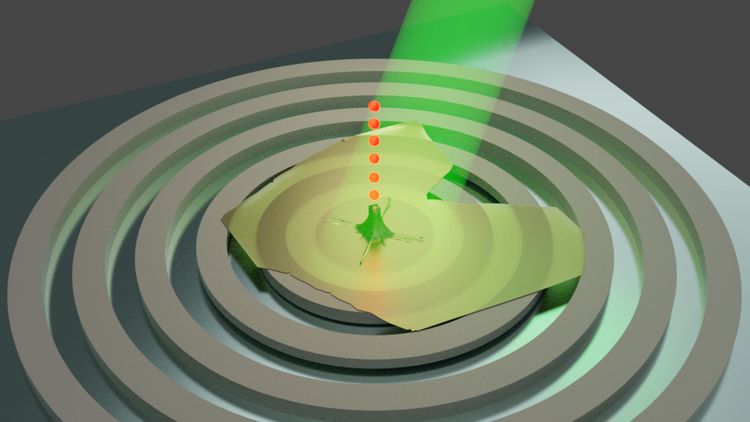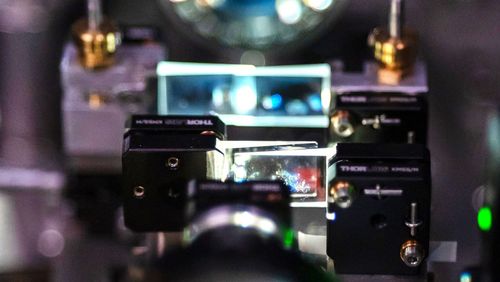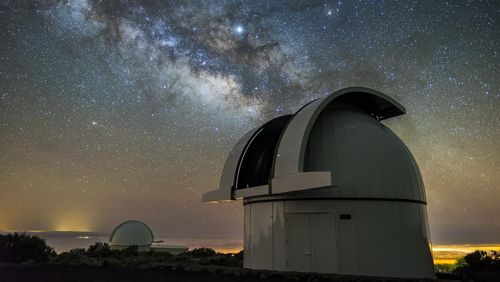Special light sources are needed to transmit information securely in quantum networks. Researchers from Oldenburg are involved in two projects in which these novel emitters are being developed.
Strange phenomena from the world of quantum physics could soon play an important role in information technology. In order to transmit information securely, so-called quantum entanglement can be used. Three physicists were awarded this year’s Nobel Prize for their research into this physical principle. It states that two particles behave like one entity, even if they are separated far away from each other.
In a future quantum network, it will be possible to transmit information securely with the help of entangled light particles – so-called photons. This is because manipulating one of the two particles would also change the other. An important prerequisite for realising quantum networks are light sources that emit single, indistinguishable photons, all with the same wavelength or polarization.
Transmitting encrypted information
Light sources like this are at the centre of two research projects in which the University of Oldenburg is collaborating. Funded as part of the QuantERA European research programme and coordinated by the Sapienza University of Rome, the goal of the EQUAISE project is to develop components that emit indistinguishable photons as efficiently as possible. The Oldenburg sub-project will receive approximately 490,000 euros over three years from the Federal Ministry of Education and Research (BMBF) and is led by Prof. Dr. Christian Schneider and Prof. Dr. Caterina Cocchi from the Institute of Physics. Schneider is also involved in the second project titled tubLAN Q.0. This project is led by the Technische Universität Berlin and revolves around quantum cryptography, which exploits quantum mechanical properties for the transmission of encrypted information. The Oldenburg sub-project will receive 350,000 euros in funding from the BMBF.
The scientists in the EQUAISE project (Enabling QUAntum Information by Scalability of Engineered quantum materials) aim to develop light sources that emit indistinguishable photons with high efficiency. The research team is focusing on atomically thin semiconductor crystals consisting of a transition metal and one of the three elements, sulphur, selenium or tellurium. Schneider's research group has already described the properties of these “two-dimensional” materials in several publications. In addition to developing the technology, the Oldenburg teams led by Schneider and Cocchi have been tasked with characterizing the light sources in greater detail and creating theoretical models of the planned components. The research consortium, which also includes scientists from the Italian National Research Council, the University of Bremen, the University of Oviedo (Spain), the Wrocław University of Science and Technology (Poland) and nanoplus Nanosystems and Technologies GmbH, a tech company based near Würzburg (Germany), is seeking an approach to make components that can transmit information over long distances via quantum networks suitable for industrial applications.
Application in a quantum network
In the second project titled tubLAN Q.0, the goal is to set up one of these quantum networks on the campus of the Technische Universität Berlin. The team plans to conduct experiments in which encrypted information is transferred between three buildings in a secure, hack-proof “quantum link”. The quantum light sources needed to create such a link will be developed and fabricated by Schneider’s team along with researchers from the Emden/Leer University of Applied Sciences and the Friedrich Schiller University of Jena, and then tested in Oldenburg and jointly put into operation in the Berlin network. "In principle, our two-dimensional quantum emitters are predestined for free-beam optical transmission in the Earth's atmosphere, but their application in quantum networks has not yet been researched," says Schneider. The team sees high potential for commercial exploitation of the project results and plans to examine options for founding a spin-off once the project comes to an end.
In the QuantERA programme, 39 public funding organisations from 31 European countries have joined forces to promote top-level research and innovations in quantum technologies. In the last funding round, 39 out of 128 applications were approved. The tubLAN Q.0 collaborative project is also part of the BMBF's funding initiative Local Area Networks for Quantum Communication (Q-LAN), which promotes application-oriented research and development of technologies for building local quantum communication networks, also known as Q-LANs.




